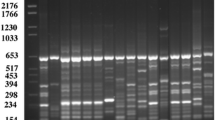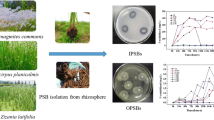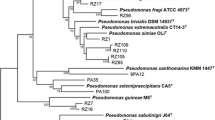Abstract
Isolation and characterization of fluorescent pseudomonads with high phosphate-solubilizing ability is reported from the alkaline and calcium-rich soils with low P availability in the cold desert region of Lahaul and Spiti in the trans-Himalayas of India. Of 216 phosphate-solubilizing isolates, 12 exhibiting high solubilization of tricalcium phosphate (TCP) in NBRIP liquid culture were identified as Pseudomonas trivialis, P. poae, P. fluorescens, and Pseudomonas spp. on the basis of phenotypic features, whole-cell fatty acids methyl ester (FAME) profiles, and 16S rDNA sequencing. These isolates also showed relatively high solubilization of North Carolina rock phosphate (NCRP) in comparison to the solubilization of Mussoorie rock phosphate (MRP) and Udaipur rock phosphate (URP). The solubilization of phosphate substrates by P. trivialis and P. poae is reported for the first time.




Similar content being viewed by others
References
Anzai Y, Kim H, Park JY, Wakabayashi H, Oyaizu H (2000) Phylogenetic affiliation of the pseudomonads based on 16S rRNA sequence. Int J Syst Evol Microbiol 50:1563–1589
Asea PEA, Kucey RMN, Stewart JWB (1988) Inorganic phosphate solubilization by two Penicillium species in solution culture and soil. Soil Biol Biochem 20(4):459–464
Bardiya S, Gaur AC (1974) Isolation and screening of microorganisms dissolving low-grade rock phosphate. Folia Microbiol 19(5):386–389
Chen YP, Rekha PD, Arun AB, Shen FT, Lai WA, Young CC (2006) Phosphate solubilizing bacteria from subtropical soil and their tricalcium phosphate solubilizing abilities. App Soil Ecol 34:33–41
Chung H, Park M, Madhaiyan M, Seshadri S, Song J, Cho H, Sa T (2005) Isolation and characterization of phosphate solubilization bacteria from the rhizosphere of crop plants of Korea. Soil Biol Biochem 37(10):1970–1974
Di Simine CD, Sayer JA, Gadd GM (1998) Solubilization of zinc phosphate by a strain of Pseudomonas fluorescens isolated from a forest soil. Biol Fertil Soils 28:87–94
Gaur AC (1990) Phosphate solubilizing microorganisms as biofertilizers. Omega Scientific Publication, New Delhi, 176 pp
Gupta R, Singal R, Shanker A, Kuhad RC, Saxena RK (1994) A modified plate assay for screening phosphate-solubilizing microorganisms. J Gen App Microbiol 40:255–260
Holt JG, Kreig NR, Sneath PHA, Stanley JT, Williams ST (1994) Bergey’s manual of determinative bacteriology. Williams and Wilkins, Baltimore, MD
Illmer P, Schinner F (1995) Solubilization of inorganic calcium phosphates-solubilization mechanisms. Soil Biol Biochem 27:257–263
Jackson ML (1973) Soil chemical analysis. Prentice Hall, New Delhi, India
Johri JK, Surange S, Nautiyal CS (1999) Occurrence of salt, pH and temperature-tolerant phosphate-solubilizing bacteria in alkaline soils. Curr Microbiol 39:89–93
Kapoor KK, Mishra MM, Kukreja K (1989) Phosphate solubilization by soil microorganisms-a review. Indian J Microbiol 29:119–127
Kloepper JW, Schroth MW (1981) Plant growth-promoting rhizobacteria under gnotobiotic conditions. Phytopathology 71:642–644
King EO, Ward MK, Raney DE (1954) Two simple media for the demonstration of pyocyanin and fluorescein. J Lab Clin Media 44:301–307
Kumar V, Singh KP (2001) Enriching vermicompost by nitrogen fixing and phosphate solubilizing bacteria. Bioresour Technol 76:173–175
Musarrat J, Bano N, Rao RAK (2000) Isolation and characterization of 2,4-dichlorophenoxyacetic acid-catabolyzing bacteria and their biodegradation efficiency in soil. World J Microbiol Biotechnol 16:495–497
Nautiyal CS (1999) An efficient microbiological growth medium for screening phosphate solubilizing microorganisms. FEMS Microbiol Lett 170:265–270
Nautiyal CS, Bhadauria S, Kumar P, Lal H, Mondal R, Verma D (2000) Stress induced phosphate solubilization in bacteria isolated from alkaline soils. FEMS Microbiol Lett 182:291–296
Pandey A, Palni LMS (1998) Isolation of Pseudomonas corrugata from Sikkim Himalaya. World J Microbiol Biotechnol 14:411–413
Peix A, Rivas R, Mateos PF, Martinez-Molina E, Rodrigue-Barrueco C, Velazquez E (2003) Pseudomonas rhizosphaerae sp. nov., a novel species that actively solubilizes phosphate in vitro. Int J Syst Evol Microbiol 53:2067–2072
Peix A, Rivas R, Santa-Regina I, Mateos PF, Martinez-Molina E, Rodrigue-Barrueco C, Velazquez E (2004) Pseudomonas lutea sp. nov., a novel phosphate-solubilizing bacterium isolated from the rhizosphere of grasses. Int J Syst Evol Microbiol 54:847–850
Qureshi AA, Narayanasamy G (1999) Direct effect of rock phosphates and phosphate solubilizers on soybean growth in a typic ustochrept. J Indian Soc Soil Sci 47:475–478
Rainey PB (1999) Adaptation of Pseudomonas fluorescens to the plant rhizosphere. Environ Microbiol 1:243–257
Rodriguez H, Fraga R (1999) Phosphate solubilizing bacteria and their role in plant growth promotion. Biotechnol Adv 17:319–339
Sasser M (1990) Technical Note 102. Tracking a strain using the Microbial Identification System. MIS, Newark, DE
Sasser M, Wichman MD (1991) Identification of microorganisms through use of gas chromatography and high-performance liquid chromatography. In: Balows A, Hausler Jr WJ, Herrman KL, Isenberg HD, Shadomy HJ (eds) Manual of clinical microbiology, 5th ed. American Society for Microbiology, Washington, DC
Singh RP, Gupta MK (1990) Soil and vegetation study of Lahaul and Spiti cold desert of Western Himalayas. Indian Forester 116:785–790
Son HJ, Park GT, Cha MS, Heo MS (2006) Solubilization of insoluble inorganic phosphates by a novel salt and pH-tolerant Pantoea agglomerans R-42 isolated from soybean rhizosphere. Bioresour Technol 97:204–210
Sutra L, Risede JM, Gardan L (2000) Isolation of fluorescent pseudomonads from the rhizosphere of banana plants antagonistic towards root necrosing fungi. Lett Appl Microbiol 31:289–293
Tripura C, Sashidhar B, Podile AR (2007) Ethyl methanesulfonate mutagenesis-enhanced mineral phosphate solubilization by groundnut-associated Serratia marcescens GPS-5. Curr Microbiol 54:79–84
Vazquez P, Holguin G, Puente ME, Lopez-Cortez A, Bashan Y (2000) Phosphate-solubilizing microorganisms associated with the rhizosphere of mangroves in a semiarid coastal lagoon. Biol Fertil Soils 30:460–468
Weisburg WG, Barns SM, Pelletier DA, Lane DJ (1991) 16S ribosomal DNA amplification for phylogenetic study. J Bacteriol 173:697–703
Acknowledgments
The authors acknowledge the Microbial Type Culture Collection and Gene Bank, Institute of Microbial Technology, Chandigarh, India, for FAME analysis. They also acknowledge the Director of the Institute of Himalayan Bioresource Technology for providing the necessary facilities, and the Department of Biotechnology, Government of India for the financial support. Thanks are also due to Mr. Digvijaya Singh Naruka for the technical support in operating the DNA sequencer.
Author information
Authors and Affiliations
Corresponding author
Rights and permissions
About this article
Cite this article
Gulati, A., Rahi, P. & Vyas, P. Characterization of Phosphate-Solubilizing Fluorescent Pseudomonads from the Rhizosphere of Seabuckthorn Growing in the Cold Deserts of Himalayas. Curr Microbiol 56, 73–79 (2008). https://doi.org/10.1007/s00284-007-9042-3
Received:
Accepted:
Published:
Issue Date:
DOI: https://doi.org/10.1007/s00284-007-9042-3




